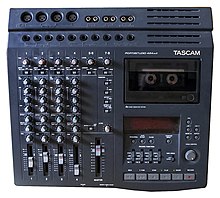This article needs additional citations for verification. (April 2010) |


The TASCAM Portastudio was the first four-track recorder based on a standard compact audio cassette tape. The term portastudio is exclusive to TASCAM, though it is generally used to describe all self-contained cassette-based multitrack recorders dedicated to music production. The Portastudio, and particularly its first iteration, the Teac 144, is credited with launching the home-recording wave, which allowed musicians to cheaply record and produce music at home,[1] and is cited as one of the most significant innovations in music production technology.[2]
The Teac 144 Portastudio made its debut in 1979, at the annual meeting of the Audio Engineering Society. It was followed by several other models by TASCAM,[3] and eventually by several other manufacturers.[4]
For the first time it enabled musicians to affordably record several instrumental and vocal parts on different tracks of the built-in four-track cassette recorder individually and later blend all the parts together, while transferring them to another standard, two-channel stereo tape deck (remix and mixdown) to form a stereo recording.[5]
The Tascam Portastudio 244, introduced in 1982, improved upon the previous design with overall better sound quality and more features, including: dbx noise reduction, dual/concentric sweepable EQ's, and the ability to record on up to 4 tracks simultaneously.[6]
In general, these machines were typically used by amateur and professional musicians to record demos, although they are still used today in lo-fi recording. The analog portastudios by TASCAM (a division of TEAC) and similar units by Fostex, Akai, Yamaha, Sansui, Marantz, Vestax, Vesta Fire, TOA, Audio-Technica, Peavey, and others generally recorded on high-bias cassette tapes. Most of the machines were four-track, but there were also six-track and eight-track units. Some newer digital models record to a hard disk, allowing for digital effects and up to 32 tracks of audio.
- ^ Molenda, Michael (2007). The Guitar Player Book: 40 Years of Interviews, Gear, and Lessons from the World's Most Celebrated Guitar Magazine. Hal Leonard Corporation. p. 180. ISBN 9780879307820.
- ^ Cameron, Samuel (2015). Music in the Marketplace: A Social Economics Approach. Routledge. p. 84. ISBN 9781317934738.
- ^ Novak, David (2013). Japanoise: Music at the Edge of Circulation. Duke UP. p. 207. ISBN 9780822397540.
- ^ "The Tascam Portastudio Through the Ages". reverb.com. 28 September 2016. Retrieved 2017-01-31.
- ^ Alberts, Randy (2003). TASCAM: 30 Years of Recording Evolution. Hal Leonard Corporation. ISBN 9780634011566.
- ^ "TASCAM Portastudio 244 Review", Home Studio Recording Magazine, no. Dec 1983, pp. 16–17, December 1983, retrieved 22 February 2023